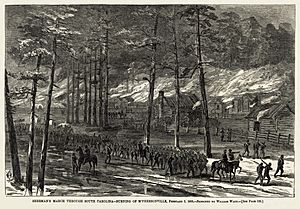McPhersonville, South Carolina facts for kids
McPhersonville is a small community in eastern Hampton County, South Carolina, United States. It is close to the borders of Beaufort and Jasper counties. Long ago, McPhersonville was an important place for wealthy families and culture in the old Prince William Parish. Today, it is mostly a marked spot on a small road between Yemassee and Early Branch.
Contents
Geography of McPhersonville
McPhersonville is located about 85 feet (26 meters) above sea level. The area around McPhersonville has many pine forests and sandy soil. This made it a popular summer escape for rich plantation owners. They came from the hotter, lower areas near the Atlantic coast. They brought their families with them to enjoy the cooler air.
Early Days of McPhersonville
Before Europeans arrived, Yemassee and Creek Native Americans lived here. They had trading posts, trails, and special places for ceremonies. The first English settlers came to the McPhersonville area in the 1670s. This was before the Carolinas were split into North and South Carolina in 1729.
McPhersonville itself was started by rice farmers. These farmers lived along the Combahee River and other nearby rivers. They liked the cool winds, lower humidity, and shady pine trees of this inland area. General James McPherson and his family were among the first people to live here. Other important families also moved to McPhersonville.
A big fight called the Yamasee War happened in 1715. It was fought mostly around McPhersonville. The Yamasee, Creeks, and other tribes fought against white traders. They were upset about unfair business deals. Many colonists died, and a lot of property was destroyed.
McPhersonville in the Revolutionary War
During the Revolutionary War, British soldiers came to McPhersonville. In March 1780, they took over the farm of Isaac McPherson. Reports from that time called him "a great Rebel" and a rich man. The British had been trying to catch 50 American soldiers on horseback.
While at McPherson's farm, the British thought they were fighting the enemy. But they accidentally attacked their own soldiers. After this, the British left McPherson's farm. They marched to the Salkehatchie River. There, 80 American soldiers tried to stop them from crossing. However, British soldiers crossed the river in another spot. They came up behind the Americans. A British captain and 16 soldiers were killed by bayonets.
McPhersonville in the Civil War
During the Civil War, McPhersonville was taken over by Union forces. This happened early in William T. Sherman's Carolinas Campaign. Only two homes built before the war and one church survived the Union Army's march through the village.
The Stoney Creek Independent Presbyterian Chapel of Prince William Parish is one of the churches that survived. It was built in 1743. This chapel was used as a hospital during the Civil War. It is now on the National Register of Historic Places.
However, the historic Prince William's Episcopal Church did not survive. It was first built in 1832 as a summer church. Sherman's army destroyed it in 1865. This was because the Confederates had used it as a hospital for people with smallpox. The Union soldiers used the church's strong wood to build bridges. They burned the rest of the church. It was rebuilt in 1898.
McPhersonville Today
After the Civil War, the economy changed a lot. Sherman's troops had also destroyed many things in McPhersonville. This led to a long period of decline for the community. Fewer people came for the summer, and the year-round population also went down.
The McPhersonville post office closed in the 1950s. Now, the community gets its mail from the Yemassee post office. There are no big businesses in McPhersonville today. However, in the last 20 years, the area has seen a small comeback. New property owners are drawn to the same good environmental conditions that attracted the first settlers.
The Stoney Creek Independent Presbyterian Chapel is now managed by a foundation. It is connected to the First Presbyterian Church in Beaufort. This chapel was also used in the movie Forrest Gump. It was the Four Square Baptist Church where Forrest Gump prayed with the choir for shrimp.
See also
 In Spanish: McPhersonville para niños
In Spanish: McPhersonville para niños


